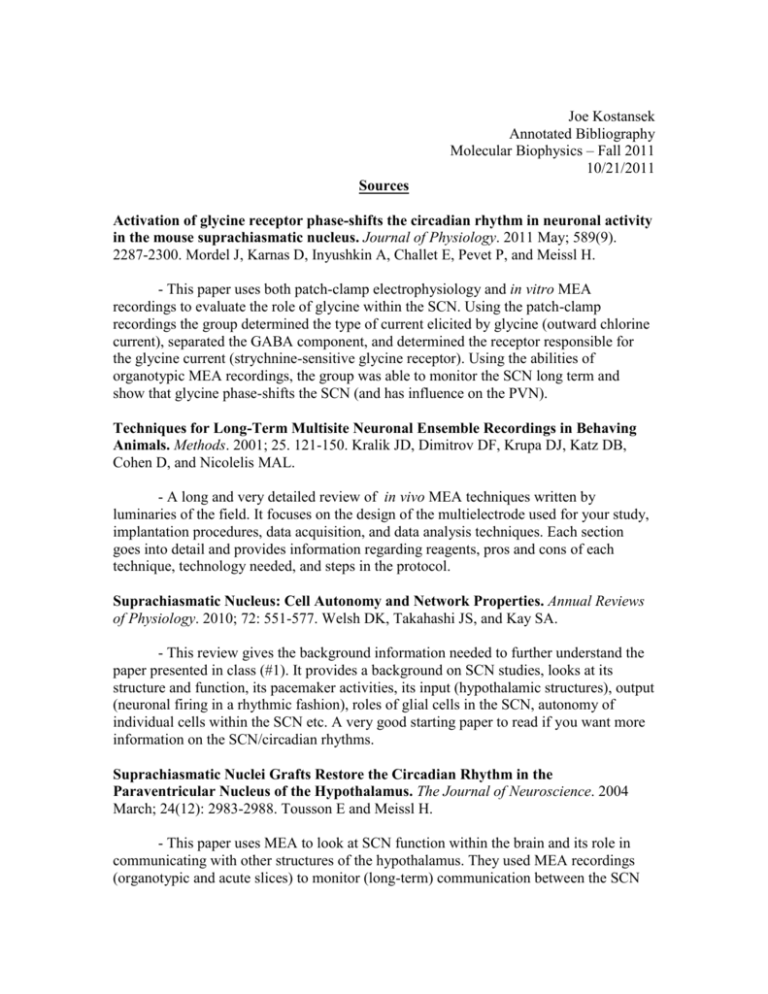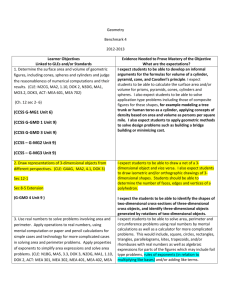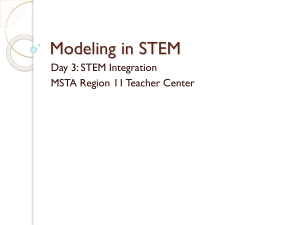Multi-electrode Arrays - Part 3
advertisement

Joe Kostansek Annotated Bibliography Molecular Biophysics – Fall 2011 10/21/2011 Sources Activation of glycine receptor phase-shifts the circadian rhythm in neuronal activity in the mouse suprachiasmatic nucleus. Journal of Physiology. 2011 May; 589(9). 2287-2300. Mordel J, Karnas D, Inyushkin A, Challet E, Pevet P, and Meissl H. - This paper uses both patch-clamp electrophysiology and in vitro MEA recordings to evaluate the role of glycine within the SCN. Using the patch-clamp recordings the group determined the type of current elicited by glycine (outward chlorine current), separated the GABA component, and determined the receptor responsible for the glycine current (strychnine-sensitive glycine receptor). Using the abilities of organotypic MEA recordings, the group was able to monitor the SCN long term and show that glycine phase-shifts the SCN (and has influence on the PVN). Techniques for Long-Term Multisite Neuronal Ensemble Recordings in Behaving Animals. Methods. 2001; 25. 121-150. Kralik JD, Dimitrov DF, Krupa DJ, Katz DB, Cohen D, and Nicolelis MAL. - A long and very detailed review of in vivo MEA techniques written by luminaries of the field. It focuses on the design of the multielectrode used for your study, implantation procedures, data acquisition, and data analysis techniques. Each section goes into detail and provides information regarding reagents, pros and cons of each technique, technology needed, and steps in the protocol. Suprachiasmatic Nucleus: Cell Autonomy and Network Properties. Annual Reviews of Physiology. 2010; 72: 551-577. Welsh DK, Takahashi JS, and Kay SA. - This review gives the background information needed to further understand the paper presented in class (#1). It provides a background on SCN studies, looks at its structure and function, its pacemaker activities, its input (hypothalamic structures), output (neuronal firing in a rhythmic fashion), roles of glial cells in the SCN, autonomy of individual cells within the SCN etc. A very good starting paper to read if you want more information on the SCN/circadian rhythms. Suprachiasmatic Nuclei Grafts Restore the Circadian Rhythm in the Paraventricular Nucleus of the Hypothalamus. The Journal of Neuroscience. 2004 March; 24(12): 2983-2988. Tousson E and Meissl H. - This paper uses MEA to look at SCN function within the brain and its role in communicating with other structures of the hypothalamus. They used MEA recordings (organotypic and acute slices) to monitor (long-term) communication between the SCN and the PVN and with other adjacent areas to the SCN – all areas were in phase with the SCN. Upon ablating the SCN, the PVN lost its rhythmic activity but was restored by a graft of the SCN onto the PVN – indicating a humoral factor (AVP) is needed for communication by the SCN to other hypothalamic structures. The Neurally Controlled Animat: Biological Brains Acting with Simulated Bodies. Autonomous Robots. 2001; 11(3): 305-310. DeMarse TB, Wagenaar DA, Blau AW, and Potter SM. - The debut paper of the “Animat”. This is an in vitro MEA paper. This paper debuts the creation of the Animat which is used to study how information is processed and encoded in living cultured neuronal networks via an interface with a computer generated animal. They use dissected cortical neurons and place on a MEA which is capable of stimulating and recording simultaneously. The stimulation of the neurons are the input of the animat and the computer is its sensory system. Many implications for robotics and algorithims that are fault tolerant and can repair themselves. This article is complete with theory, methods and data. Computation within cultured neural networks. Conference Proceedings Annual International Conference of the IEEE Engineering in Medicine and Biological Society. 2004; 7:5340-5343. DeMarse T, Cadotte A, Douglas P, He P, and Trinh V. - Similar to the Animat paper above, this paper too uses in vitro MEA recordings to study the dynamics of neural networks. MEA’s in this paper function to stimulate and record from 60 different sites across the population of neurons. Using this technique they send stimulation patterns into the culture and record their responses to then study how networks compute. They use two network theories to this end (chaotic control and LSM model) and integrated into the study of how these networks compute and offer feedback in the realm of a flight simulator. (This is the “rat neurons fly a plane” paper). Three-dimensional micro-electrode array for recording dissociated neuronal cultures. Lab on a Chip. 2009 July; 9(14): 2036-2042. Musick K, Khatamia D, and Wheeler BC. - This paper, in detail outlines the 3D MEA technique and includes sections on design and fabrication of the MEA and provides experiments showing proof that the 3D design works. The authors claim that the 3D electrode design offer more realistic conclusions than monolayer cultures (which do not include extracellular matieral). Figures and methods to design and build your own 3D MEA electrode are included. The 4-aminopyridine in vitro epilepsy model analyzed with a perforated multielectrode array. Neuropharmacology. 2011; 60:1142-1153. Gonzalez-Sulser A, Wang J, Motamedi GK, Avoli M, Vicini S, and Dzakpasu R. - This paper highlights the use of the perforated multi-electrode array in a study of epilepsy. The perforated MEA technique is similar to that of the patch-clamp in that negative pressure is applied to create a seal between the tissue being studied and the MEA device – just as a seal is used to create the patch on a single cell. The authors measured ictal and ictal-like events over 60 channels and used the benefits of the perforated MEA (ease of drug application) to block GABAergic and glutamatergic transmission to find that multiple synaptic mechanisms contribute to synchronize neuronal network activity in the forebrain. Implantable microscale neural interfaces. Biomedical Microdevices. 2007; 9: 923-938. Cheung KC. - A much shorter review of in vivo MEAs than the Kralik review that focuses on electrode type (array shape, materials used to construct the electrodes, and in which kind of experiments these particular electrodes are made for), tissue response to chronically implanted probes and the strategies used to relieve inflammation and scar formation (can damage tissue in/around the array), considerations of electronics and further applications of MEA technology (mentioning neuroprosthetic devices). A novel organotypic long-term culture of the rat hippocampus on substrateintegrated multielectrode arrays. Brain Research Protocols 1998; 2:229-243. Egert U, Schlosshauer B, Fennrich S, Nisch W, Fejtl M, Knott T, Muller T, and Hammerle H. - This is a protocol paper which provides one of the first protocols to ever use the organotypic MEA technique. It provides information regarding the type of research this technique is applicable, the time required for the protocol, materials needed, and steps to fabricate your own MEA. It also provides a short experiment to show the efficacy of this (at that time) new technique. Interesting Links: http://www.qwane.com/mea_references.html - This is the website of a company that looks to further develop tools/techniques in multi/micro electrode recording. This particular page references important papers in the development in MEA technology (3D arrays, thin film, organotypic) as well as their applications. Good place to start if you are looking for papers to read. http://www.multichannelsystems.com/ - The website for (probably) the most popular developer/supplier of tools/electronics used for multi-electrode array recording. Good if you want to know which pieces of technology you need to buy if you are to start your own MEA rig. Also contains products for other electrophysiological techniques. Information and prices included. http://en.wikipedia.org/wiki/Multielectrode_array - This is the Wikipedia entry for multi electrode arrays – good if you want a general summary of the technique and its history. It contains sections covering: theory, history, types (in vitro, in vivo), data processing methods, advantages/disadvantages, and applications. Contains citations used to create the article as well as links to other articles relating to this one. http://www.jove.com/video/2949/multi-electrode-array-recordings-ofneuronal-avalanches-in-organotypic-cultures - An entry in the Journal of Visualized Experiments – “Multi-electrode Array Recordings of Neuronal Avalanches in Organotypic Cultures”. This article summarizes the protocol needed to study cortical avalanches while using organotypic in vitro MEA. It contains a 15 minute video summarizing the article with sections including: preparation of glass chamber with integrated MEA, cortex and VTA tissue dissection, mounting cortext and VTA tissue slices on MEA, electrophysiological recordings, results and conclusion. The article also goes over possible technical issues. http://www.giugliano.info/public/reprints/ebs1336.pdf - This site is an article from the Wiley Encyclopedia of Biomedical Engineering (2006) written by M. Giugliano. Its title is “Substrate arrays of microelectrodes for in vitro electrophysiology”. It covers MEA techniques solely at the in vitro level. It contains sections such as: MEA fabrication (with pictures), complementary techniques, organotypic slices, dissociated neurons, pharmacology and a section covering the electrical stimulation of the nervous system (network theory). A good summary/review article. http://www.youtube.com/watch?v=E8l3_kAUe0w - Video! This video is a 10 minute talk featuring Steve Potter from Georgia Tech. In this video he is summarizing his MEA technique and how he uses it in his research. He focuses on using MEA to control a hybrid computer animal – “Animat”. This video covers one of the most interesting applications of MEA technology. http://www.neuro.gatech.edu/wp/labs/potter/meas/ - This is the lab website of Steve Potter (the same from the video above) at Georgia Tech. It provides his research interest “Multielectrode arrays for stimulating and recording mammalian neurons”, provides a general summary, links for further reading for MEA technology, mailing lists, groups, companies, and a section devoted to animats. http://tech.groups.yahoo.com/group/mea-users/ - A yahoo answers group devoted to providing answers for questions as well as general information related to MEAs. http://www.sdr.com.au/arrays.html - A good site to use along with the multichannel systems site, it provides a general overview of the materials needed for a MEA rig. It provides applications, benefits, and some information for each piece of technology needed to use MEA technology. It recommends purchasing from Multichannel Systems. http://osiris.rutgers.edu/~smm/extracellular_eclectrophysiology.htm - MEA is used for extracellular recordings. Don’t know what that is? Need a refresher that is not buried within a dense journal article? This site has a nice, easy to read overview of extracellular recordings – important for understanding/using MEA technology.








